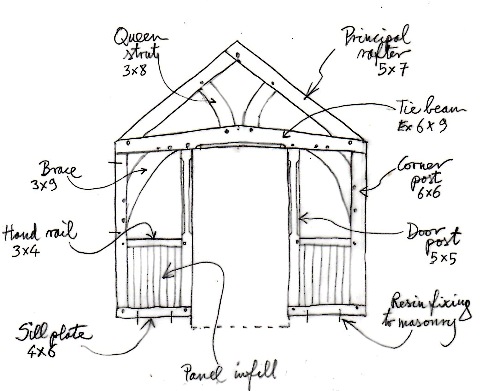How much does a frame cost?
The most typical and fairly self-evident answer to this question involves the length of a piece of string… After all the frames I build are bespoke and every design and situation is different. But actually a very rough idea can be given, as long as the person asking the question accepts that the figures are only intended as a very rough guide and can vary enormously, either up or down, depending on a large number of factors.
In 2009 Grand Designs Magazine did a fairly extensive survey comparing the costs of different methods of construction and traditional timber framing came out higher than the average, but not the highest.
Here are the results in cost per square meter:
Pre-cast concrete £1,200 - £1,500
Steel frame £1,000 - £1,100
Brick and block £900 - £1,100
Conventional timber frame £750 - £950 (nailed softwood stick frame)
Traditional timber frame £1,000 - £1,200 (jointed green timber frame)
It is worth bearing in mind though that these are square meter prices for the whole build, including elements such as kitchens, fixtures and fittings etc. and that since oak framing is, at present, generally associated with high-end builds, it means that very often an oak framed house also has a very expensive kitchen, bathroom, finishes etc. which will have pushed this survey sq/m price up.
Many green oak frame projects have been built that achieved a much lower sq/m price than that quoted above simply because the clients were in love with oak frames but not so concerned about whether their taps were made of unobtanium or not. 
The percentage contribution that a traditional jointed timber frame makes to the overall build cost (typically18% to 25%) varies most as a result of the overall design of the building, which is why, as is mentioned elsewhere, it can be very worthwhile inviting the chosen framer to join architectural design discussions at an early conceptual stage, especially if the architect has limited knowledge of the construction method. This is quite common since there are not many architects that have a thorough understanding of the design of oak framed buildings.
It is usually possible to tailor the frame design to the client’s budget by varying the complexity of the frame, since it is the amount and intricacy of the joinery that most affects the final price, rather than the size of the frame or the amount of timber in it.
And it goes without saying that a rather too common way of getting the price down is by engaging a framer who keeps prices low by skimping on frame quality, quality of service, reliability, certification, safety etc. I do not engage in this sort of cost cutting excercise and have made it my aim for J. Rose Carpentry to be producing the highest quality frames. This of course does have a cost implication, but I can partly offset it through the savings made by populating the business with people who enjoy long years of experience and high levels of skill, thus keeping overheads low and productivity high.
by engaging a framer who keeps prices low by skimping on frame quality, quality of service, reliability, certification, safety etc. I do not engage in this sort of cost cutting excercise and have made it my aim for J. Rose Carpentry to be producing the highest quality frames. This of course does have a cost implication, but I can partly offset it through the savings made by populating the business with people who enjoy long years of experience and high levels of skill, thus keeping overheads low and productivity high.
High quality admittedly means that overall my prices are not as cheap as the cheapest in the industry, but I think I can nevertheless be very competitive when compared with the average. I have to pin my hopes on the fact that most specifiers and selfbuilders know that price can not be considered independently of quality, speed and reliability. Fortunately such judgements are usually based on value not just simple price.
Ruskin said: "There is nothing in the world that some man can not make a little worse and sell a little cheaper, and he who considers price only is that man's lawful prey".
J. Rose Carpentry